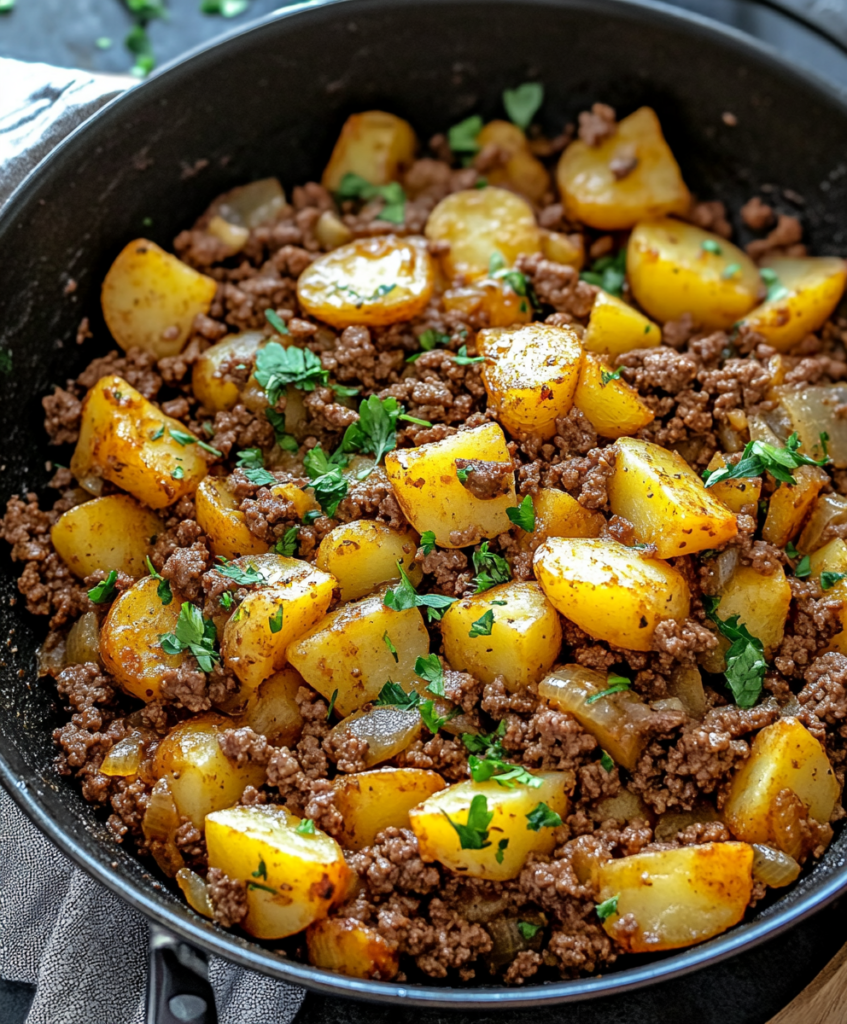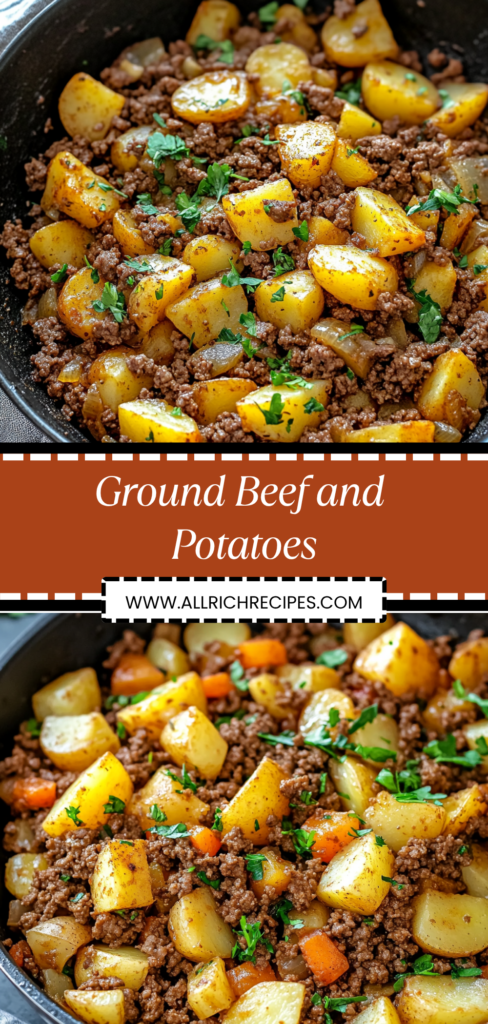
This humble skillet dinner transforms everyday ingredients into something extraordinary. It’s the kind of meal that fills your kitchen with aromas that transport you straight to your grandmother’s house—where cast iron skillets held family secrets and dinner meant gathering around something hearty, satisfying, and made with love. This one-pan wonder delivers crispy potatoes, perfectly seasoned beef, and a medley of flavors that prove simple food can be spectacular.
Ingredients
For the Main Dish:
- 1½ pounds ground beef (80/20 blend)
- 2 pounds Yukon Gold potatoes, diced into ½-inch cubes
- 1 large onion, diced
- 1 red bell pepper, diced
- 1 green bell pepper, diced
- 4 cloves garlic, minced
- 3 tablespoons olive oil, divided
- 2 tablespoons butter
- 1 tablespoon Worcestershire sauce
- 2 teaspoons smoked paprika
- 1½ teaspoons dried thyme
- 1 teaspoon garlic powder
- 1 teaspoon onion powder
- ½ teaspoon cayenne pepper (optional)
- Salt and black pepper to taste
- 1 cup beef broth
- 1 cup shredded sharp cheddar cheese (optional)
For Garnish:
- Fresh parsley, chopped
- Green onions, sliced
- Sour cream
- Hot sauce
Instructions
- Prep the Potatoes: Dice potatoes into uniform ½-inch cubes, keeping them in cold water until ready to use. This prevents browning and removes excess starch. Just before cooking, drain and pat completely dry with paper towels.
- Start with Potatoes: Heat 2 tablespoons olive oil and butter in a large cast-iron or heavy-bottomed skillet over medium-high heat. Add dried potatoes in a single layer. Don’t stir for the first 5 minutes—let them develop a golden crust. Season with salt and pepper.
- Continue Cooking Potatoes: Flip potatoes and cook another 5-7 minutes, stirring occasionally, until golden on multiple sides and almost tender. Transfer to a plate and set aside.
- Brown the Beef: In the same skillet, add ground beef. Break into large chunks and let sear undisturbed for 3-4 minutes to develop a crust. Then break apart and continue cooking until browned throughout. Season with salt, pepper, and half the paprika.
- Build Flavor Base: Push beef to the edges of the pan. Add remaining olive oil to center, then add onions. Cook for 3 minutes until softening. Add bell peppers and cook another 3 minutes. Stir in garlic, remaining paprika, thyme, garlic powder, onion powder, and cayenne.
- Deglaze and Combine: Pour in Worcestershire sauce and beef broth, scraping up any browned bits. Return potatoes to the skillet, gently folding everything together. Reduce heat to medium-low.
- Finish Cooking: Simmer uncovered for 8-10 minutes, stirring occasionally, until potatoes are fully tender and liquid has mostly evaporated. The mixture should be moist but not soupy.
- Optional Cheese Finish: Remove from heat, sprinkle cheese over top if using, and let melt for 2 minutes. Garnish with fresh herbs and serve immediately.
Recipe Notes
- Prep Time: 20 minutes
- Cook Time: 35 minutes
- Total Time: 55 minutes
- Servings: 6 hearty portions
- Calories: 420 per serving (without cheese)
Why This Recipe Works Like Magic
The beauty of this dish lies in the Maillard reaction—that magical browning that happens when proteins and sugars hit high heat. By cooking components separately before combining, we’re maximizing flavor development at every stage. Those crispy potato edges aren’t just about texture; they’re flavor bombs created by caramelization.
The 80/20 ground beef blend is crucial. That 20% fat renders out during cooking, essentially frying the potatoes in beef drippings—a flavor you simply can’t replicate with leaner meat. As the fat renders, it carries fat-soluble flavor compounds from the spices throughout the dish, ensuring every bite is perfectly seasoned.
Yukon Gold potatoes earn their place here through their medium starch content. They hold their shape better than russets while developing crispy exteriors, and their naturally buttery flavor complements the beef beautifully. The cold water bath removes surface starch that would otherwise cause sticking and mushiness.
The Art of Skillet Management
Your skillet choice impacts everything. Cast iron is ideal—its heat retention ensures even cooking and helps achieve that coveted crust on both potatoes and beef. If using stainless steel, increase the oil slightly and watch your heat more carefully.
Temperature control separates good skillet dinners from great ones. That initial medium-high heat for potatoes is non-negotiable—lower temperatures steam rather than sear. But once everything’s combined, reducing to medium-low prevents scorching while allowing flavors to meld.
The “don’t stir” rule for the first 5 minutes of potato cooking requires patience but pays dividends. Moving them too early prevents crust formation and can cause sticking. Trust the process—when they’re ready to flip, they’ll release easily from the pan.
Ingredient Deep Dive
Ground Beef Selection: While 80/20 is ideal, 85/15 works with slight adjustments—add an extra tablespoon of oil for the potatoes. Avoid anything leaner than 85/15; the dish becomes dry and lacks the rich, beefy flavor that makes this special.
Potato Prep Perfection: That ½-inch dice isn’t arbitrary. Smaller pieces cook too quickly and turn mushy; larger pieces remain hard when the beef is ready. Consistent sizing ensures even cooking. A sharp knife matters—clean cuts create more surface area for crisping than ragged edges from dull blades.
The Bell Pepper Debate: Using both red and green peppers isn’t just about color. Red peppers bring sweetness that balances the savory elements, while green peppers add a slight bitter note that prevents the dish from becoming one-dimensional. Yellow or orange peppers can substitute for red.
Spice Strategy: Smoked paprika is the secret weapon, adding depth that regular paprika can’t match. The combination of garlic and onion powders with fresh garlic and onions creates layers of allium flavor—immediate sharpness from fresh, mellow sweetness from dried.
Technique Troubleshooting
“My potatoes are mushy”: Either cut too small, overcooked, or stirred too frequently. Next time, ensure uniform ½-inch cubes, reduce initial cooking time by 2 minutes, and resist excessive stirring.
“Everything tastes bland”: Season in layers—potatoes alone, beef alone, then the complete dish. Taste before adding broth; it’s easier to add salt than remove it. That final seasoning after cooking is crucial as flavors concentrate during reduction.
“Too greasy”: Your beef was likely too fatty or heat too low to properly render. Drain excess fat after browning beef, leaving just 1-2 tablespoons in the pan. If needed, blot with paper towels before the final combination.
“Potatoes aren’t crispy”: Moisture is the enemy of crispiness. Ensure potatoes are bone-dry before cooking. Don’t overcrowd the pan—cook in batches if necessary. That single layer with breathing room is essential for proper browning.
“Burns on the bottom”: Heat too high during the simmering stage or insufficient liquid. Once combined, maintain medium-low heat and stir every 3-4 minutes, scraping the bottom. Add broth in ¼-cup increments if needed.

Elevation Ideas
Loaded Skillet Style: After cooking, top with cheese, bacon bits, sour cream, and chives. Return to oven at 400°F for 5 minutes to melt cheese. Essentially a deconstructed loaded baked potato meets beef.
Mexican-Inspired: Add 1 tablespoon chili powder, 1 teaspoon cumin, and a can of drained black beans with the broth. Top with Mexican cheese blend, fresh cilantro, lime wedges, and serve with tortillas.
Shepherd’s Pie Variation: Add frozen peas and corn in the last 5 minutes. Transfer to a baking dish, top with prepared mashed potatoes, and broil until golden.
Breakfast Transformation: Form wells in the finished dish, crack eggs into them, cover, and cook until eggs are set. The ultimate hearty breakfast skillet.
Mediterranean Twist: Replace paprika with oregano, add chopped tomatoes and olives with the broth, finish with crumbled feta and fresh dill.
Make-Ahead and Storage Wisdom
This dish actually improves overnight as flavors meld. Cool completely before refrigerating in an airtight container for up to 4 days. The potatoes may lose some crispiness but gain in flavor integration.
Reheating for Best Results: Skillet reheating returns some original texture. Add a splash of broth and a pat of butter, heat over medium, stirring occasionally. Microwave works but sacrifice texture for convenience.
Freezing Guidelines: Freeze in portion-sized containers for up to 3 months. The potatoes’ texture changes slightly but remains acceptable. Thaw overnight in refrigerator and reheat with extra liquid to compensate for moisture loss.
Meal Prep Champion: Brown beef and cook potatoes separately on Sunday. Store separately and combine with vegetables for quick weeknight dinners. Fresh vegetables can be prepped and stored in water (peppers, onions) for 3 days.
Serving Suggestions
While this skillet is a complete meal, strategic additions elevate the experience:
Simple Sides:
- Crusty bread for soaking up flavorful pan juices
- Crisp green salad with tangy vinaigrette to cut richness
- Steamed green beans or roasted Brussels sprouts for vegetable variety
- Pickled jalapeños or banana peppers for acidic contrast
Beverage Pairings:
- Cold beer complements the hearty flavors perfectly
- Full-bodied red wine like Malbec or Zinfandel
- For non-alcoholic options, ginger beer or robust iced tea
Scaling for Crowds
This recipe doubles beautifully for feeding a crowd. Use two skillets rather than overcrowding one—maintaining that crucial breathing room for proper browning. Cook components separately as written, then combine in a large Dutch oven for the final simmer.
For parties, set up a “skillet bar” with various toppings: shredded cheeses, sour cream, hot sauces, fresh herbs, crispy onions, pickled vegetables. Let guests customize their portions.
The Economics of Comfort
This meal exemplifies budget-friendly cooking without sacrificing satisfaction. At roughly $12-15 total ingredient cost, you’re feeding 6 people heartily for under $3 per serving. Compare that to fast food or takeout, and you’re saving money while eating better.
Buying potatoes in bulk and ground beef on sale makes this even more economical. The dish uses pantry staples most cooks have on hand, requiring only fresh vegetables as special purchases.
Historical Context and Cultural Significance
Skillet dinners like this have roots in American frontier cooking, where single-pot meals were born of necessity. Cast iron skillets were prized possessions, often passed through generations. This modern version maintains that tradition of resourcefulness while incorporating flavors that reflect our diverse culinary landscape.
The combination of beef and potatoes appears in various forms across cultures—from English cottage pie to South American lomo saltado to American hash. This version represents the melting pot of American home cooking, where simple ingredients meet global flavors.
Final Thoughts
This ground beef and potato skillet embodies everything wonderful about home cooking—it’s approachable yet satisfying, economical yet delicious, simple yet sophisticated in its layering of flavors and textures. It’s the kind of meal that brings families together on busy weeknights and creates the memories that last. Master this basic recipe, and you’ll have a foundation for countless variations that reflect your family’s tastes and whatever’s in your pantry. Sometimes the best dinners aren’t the fanciest—they’re the ones that fill your home with warmth and your table with happiness.